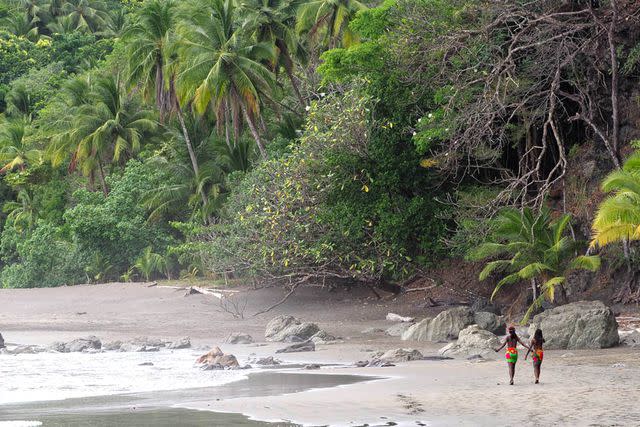Visit a Remote National Park, Learn Tribal Traditions in the Rainforest, and Swim Under a Waterfall on This Central America Cruise
On an eye-opening stop in Panama, Smithsonian Journeys changed my mind about cruising.

Pat LeBlanc/Travel + Leisure
We come ashore with a slosh, the frayed edges of a wave splashing over our dinghy as it pulls into a small cove at the edge of lime-colored hillside.
Six men wearing beads around their necks beat out a rhythm on drums as I swing my legs over the side of the boat and lurch onto the beach.
My stop here in Panama’s remote Darien National Park is part of a week-long Smithsonian Journeys cruise through Central America aboard Le Bellot, a small ship in the French-based Ponant line. Unlike the cruise I took last year, aboard a megaship with its own carousel, surf machine, and ice-skating rink, this one caters to passengers who would rather absorb lectures about maritime history and biodiversity than participate in a sexy legs contest.
Smithsonian Journeys cater to passengers interested in absorbing lectures about maritime history and biodiversity.
We boarded in Colon, Panama, and will finish in Costa Rica. So far, I feel like I’ve gotten a front row seat in a college class that touches on environmental issues and history.
After spending a day in the San Blas Islands, we motored through the Panama Canal. The first of six locks hoisted our ship 85 feet up to Gatun Lake; on the other side, we eased slowly back down.
Lake levels this year have dropped due to drought, and canal officials have reduced the number of ships that transit each day. The entire 51-mile trip took Le Bellot about eight hours, and for the last 30 minutes I climbed onto an inflatable unicorn and floated in the pint-sized pool on the ship’s back deck.
Along the way, we listened to commentary. France started construction of the canal in 1881 and the United States took over in 1904. More than 25,000 workers died from accidents and disease before it opened in 1914.
The next day included a visit to the Punta Culebra Nature Center in Panama City, where a three-toed sloth dangled from a tree out front. The long-haired hippie shuffled slowly down a branch as we entered the center, operated by the Smithsonian Tropical Research Institute.
Exhibits highlight work being done to protect amphibians from a fungus that dries their skin. I admired a tangerine-colored Panamanian golden frog, now functionally extinct in the wild. Scientists here also work with shipping authorities to channel boat traffic through designated lanes, reducing collisions with whales.
But today’s meeting with the Embera tribe in the Darien National Park is the trip’s highlight.

Pat LeBlanc/Travel + Leisure
In all, about 12,000 Embera live in scattered settlements throughout this rainforest, and their language and traditions have remained the same for generations. Most women don’t wear tops; men wear strips of fabric tied at the waist. They use jagua, a type of fruit from the jungle, to decorate their skin with temporary tattoos.
Government officials recommend traveling in the park only with a guide. We spend half a day watching dance demonstrations and learning how the people weave plants into intricate baskets and ornaments, then swim in a waterfall.
This is the part of travel that sticks with me. It’s not the size of the ship or the entertainment on board, it’s what I learn along the way. I’ve never been a big fan of cruises, but this one changed my mind.
For more Travel & Leisure news, make sure to sign up for our newsletter!
Read the original article on Travel & Leisure.

